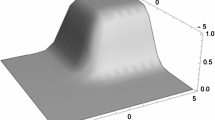Abstract
This paper aims at examining the term structure of interest rates and European-type interest rate option prices in a partially observable economy. It extends the existing literature on incomplete information by developing a one-factor model which is consistent with the initial yield curve and by providing closed-form solutions for discount bonds and different kinds of options. The model of this paper encompasses Hull and White’s (1990). Moreover, through a numerical example, these two models are compared and the impact of incomplete information on option prices is analysed.
Similar content being viewed by others
References
Björk, T. and B.J. Christensen. (1999). “Interest Rate Dynamics and Consistent Forward Curves.” Mathematical Finance, 3, 323–348.
Black, F. (1976). “The Pricing of Commodity Contracts.” Journal of Financial Economics, 3, 167–179.
Black, F. and P. Karasinski. (1991). “Bond and Option Pricing when Short Rates are Lognormal.” Financial Analysts Journal, 47, 52–59.
Brennan, M. (1998). “The Role of Learning in Dynamic Portfolio Decisions.” European Finance Review, 1, 295–306.
Brennan, M. and E. Schwartz. (1979). “A Continuous Time Approach to the Pricing of Bonds.” Journal of Banking and Finance, 3, 133–155.
Carverhill, A. (1994). “When is The Short Rate Markovian?” Mathematical Finance, 4, 305–312.
Courtadon, G. (1982). “The Pricing of Options on Default-Free Bonds.” Journal of Financial and Quantitative Analysis, 17, 75–100.
Cox, J., J. Ingersoll, and Stephen Ross. (1985a). “An Intertemporal General Equilibrium Model of Asset Prices.” Econometrica, 53, 363–384.
Cox, J., J. Ingersoll, and Stephen Ross. (1985b). “A Theory of the Term Structure of Interest Rates.” Econometrica, 53, 385–407.
Detemple, J. (1986). “Asset Pricing in a Production Economy with Incomplete Information.” The Journal of Finance, 41, 383–391.
Detemple, J. (1991). “Further Results on Asset Pricing with Incomplete Information.” Journal of Economic Dynamics and Control, 15, 425–453.
Detemple, J. and S. Murthy (1991). “Intertemporal Asset Pricing with Heterogeneous Beliefs.” Journal of Economic Theory, 62, 294–320.
Detemple, J. (2002). “Asset Pricing in an Intertemporal Partially-Revealing Rational Expectations Equilibrium.” Journal of Mathematical Economics, 38, 219–248.
Dothan, M. and D. Feldman. (1986). “Equilibrium Interest Rates and Multiperiod Bonds in a Partially Observable Economy.” The Journal of Finance, 41, 369–382.
Dothan, U. (1978). “On the Term Structure of Interest Rates.” Journal of Financial Economics, 6, 59–69.
Duffie, D. and C. Huang. (1985). “Implementing Arrow-Debreu Equilibria by Continuous Trading of Few Long-Lived Securities.” Econometrica, 53, 1337–1356.
Feldman, D. (1989). “The Term Structure of Interest Rates in a Partially Observable Economy.” The Journal of Finance, 44, 789–812.
Feldman, D. (2001). “Production and the Real Rate of Interest: A Sample Path Equilibrium.” European Finance Review, 5, 239–267.
Feldman, D. (2003). “The Term Structure of Interest Rates: Bounded or Falling.” European Finance Review, 7, 103–113.
Feldman, D. (2005). “Incomplete Information Equilibria: Separation Theorems and Other Myths.” Annals of Operations Research, forthcoming.
Gennotte, G. (1986). “Optimal Portfolio Choice under Incomplete Information.” The Journal of Finance, 41, 733–746.
Heath, D., R. Jarrow, and R. Morton. (1992). “Bond Pricing and the Term Structure of Interest Rates: A New Methodology for Contingent Claims Valuation.” Econometrica, 60, 77–105.
Ho, T. and S. Lee. (1986). “Term Structure Movements and Pricing Interest Rate Contingent Claims.” The Journal of Finance, 41, 1011–1028.
Hull, J. (2003). Options. Futures and Other Derivatives. Prentice Hall.
Hull, J. and A. White. (1990). “Pricing Interest-Rate-Derivative Securities.” The Review of Financial Studies, 4, 573–592.
Jamshidian, F. (1989). “An Exact Bond Option Formula.” The Journal of Finance, 44, 205–209.
Liptser, R. and A. Shiryayev. (1977). Statistics of Random Processes I and II: General Theory. Springer-Verlag.
Longstaff, F. (1990). “The Valuation of Options on Yields.” Journal of Financial Economics, 26, 97–121.
Lucas, R. (1978). “Asset Prices in an Exchange Economy.” Econometrica, 46, 1429–1445.
Merton, R. (1971). “Optimum Consumption and Portfolio Rules in a Continuous-Time Model.” Journal of Economic Theory, 3, 373–413.
Merton, R. (1973). “An Intertemporal Capital Asset Pricing Model.” Econometrica, 41, 867–887.
Riedel, F. (2000). “Decreasing Yield Curves in a Model with an Unknown Constant Growth Rate.” European Finance Review, 4, 51–67.
Vasicek, O. (1977). “An Equilibrium Characterization of the Term Structure.” Journal of Financial Economics, 5, 339–348.
Xia, Y. (2001). “Learning about Predictability: The Effects of Parameter Uncertainty on Dynamic Asset Allocation.” The Journal of Finance, 56, 205–245.
Yan, H. (2000). “Uncertain Growth Prospects, Estimation Risk and Asset Pricing.” Working Paper. Graduate School of Business, University of Texas at Austin.
Author information
Authors and Affiliations
Corresponding author
Additional information
This article was completed when the author was at the University of Cergy-Pontoise. He is now at the University of Paris 1 Panth éon-Sorbonne, PRISM, 17, rue de la Sorbonne, 75231 Paris Cedex 05. e-mail: constantin.mellios@univ-paris1.fr.
Rights and permissions
About this article
Cite this article
Mellios, C. Interest rate options valuation under incomplete information. Ann Oper Res 151, 99–117 (2007). https://doi.org/10.1007/s10479-006-0128-2
Published:
Issue Date:
DOI: https://doi.org/10.1007/s10479-006-0128-2




